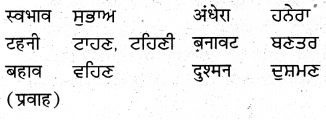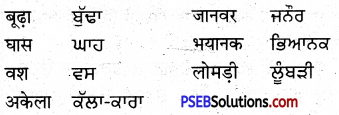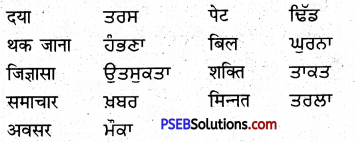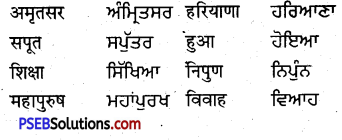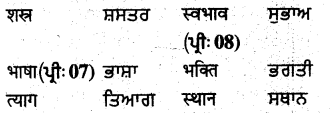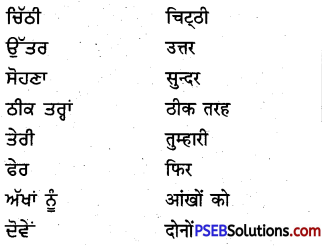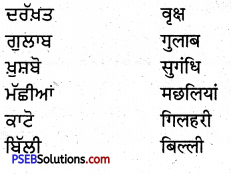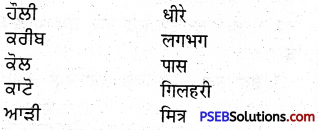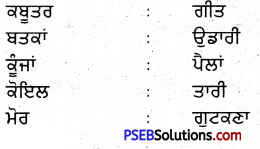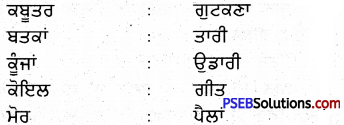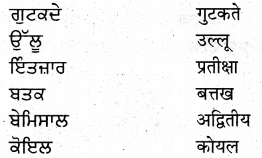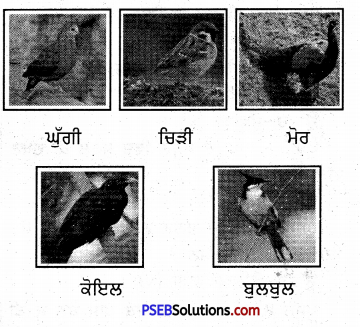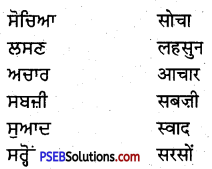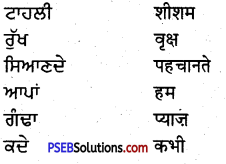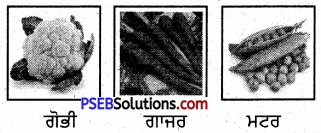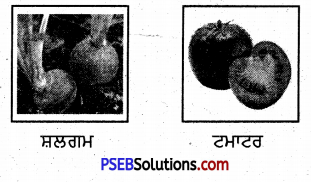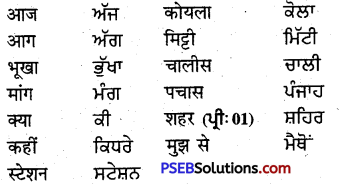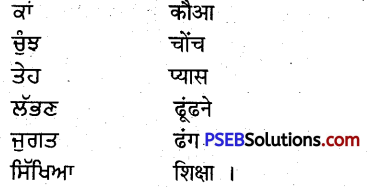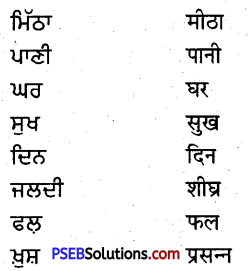Punjab State Board PSEB 5th Class Punjabi Book Solutions Chapter 16 ਸ਼ਹੀਦੀ ਜੋੜ-ਮੇਲਾ Textbook Exercise Questions and Answers.
PSEB Solutions for Class 5 Punjabi Chapter 16 ਸ਼ਹੀਦੀ ਜੋੜ-ਮੇਲਾ
1. ਖ਼ਾਲੀ ਸਥਾਨ ਭਰੋ :-
ਪ੍ਰਸ਼ਨ-ਖ਼ਾਲੀ ਥਾਂਵਾਂ ਭਰੋ-
(ਉ) ਮੁਗਲਾਂ ਨੇ ਅਨੰਦਪੁਰ ਸਾਹਿਬ ਦੇ …….. ਘੇਰਾ ਪਾਇਆ ।
(ਅ) ਮੁਗ਼ਲ ਫ਼ੌਜ ……… ਤੋੜ ਕੇ ਗੁਰੂ ਜੀ ਦਾ ਪਿੱਛਾ ਕਰਨ ਲੱਗੀ ।
(ਈ) ਗੰਗੂ ਗੁਰੂ-ਘਰ ਦਾ ………. ਸੀ .
(ਸ) ਸਾਹਿਬਜ਼ਾਦਿਆਂ ਨੂੰ ………… ਬਦਲਣ ਲਈ ਮਜਬੂਰ ਕੀਤਾ ਗਿਆ ।
(ਹ) ਇਹ ਮੇਲਾ ਪਿਛਲੇ ਸਮੇਂ ਵਿੱਚ ……….. ਦੇ ਤੌਰ ‘ਤੇ ਮਨਾਇਆ ਜਾਂਦਾ ਸੀ ।
ਉੱਤਰ:
(ੳ) ਮੁਗ਼ਲਾਂ ਨੇ ਅਨੰਦਪੁਰ ਸਾਹਿਬ ਦੇ ਕਿਲ੍ਹੇ ਨੂੰ ਘੇਰਾ ਪਾਇਆ ।
(ਅ) ਮੁਗ਼ਲ ਫ਼ੌਜ ਕਸਮਾਂ ਤੋੜ ਕੇ ਗੁਰੂ ਜੀ ਦਾ ਪਿੱਛਾ ਕਰਨ ਲੱਗੀ ।
(ਈ) ਗੰਗੂ ਗੁਰੂ-ਘਰ ਦਾ ਰਸੋਈਆ ਸੀ ।
(ਸ) ਸਾਹਿਬਜ਼ਾਦਿਆਂ ਨੂੰ ਧਰਮ ਬਦਲਣ ਲਈ ਮਜਬੂਰ ਕੀਤਾ ਗਿਆ ।
(ਹ) ਇਹ ਮੇਲਾ ਪਿਛਲੇ ਸਮੇਂ ਵਿੱਚ ਸ਼ੋਕ-ਸਭਾ ਦੇ ਤੌਰ ‘ਤੇ ਮਨਾਇਆ ਜਾਂਦਾ ਸੀ ।
2. ਇੱਕ-ਦੋ ਸ਼ਬਦਾਂ ਵਿੱਚ ਉੱਤਰ ਦਿਓ :-
ਪ੍ਰਸ਼ਨ 1.
ਪਰਿਵਾਰ-ਵਿਛੋੜਾ ਗੁਰਦਵਾਰਾ ਕਿੱਥੇ ਸੁਸ਼ੋਭਿਤ ਹੈ ?
ਉੱਤਰ:
ਸਰਸਾ ਨਦੀ ਦੇ ਕੋਲ ।
ਪ੍ਰਸ਼ਨ 2.
ਔਖੀ-ਘੜੀ ਵਿੱਚ ਮਜ਼ਲੂਮਾਂ ਦੀ ਢਾਲ ਕੌਣ ਬਣਿਆ ?
ਉੱਤਰ:
ਸ੍ਰੀ ਗੁਰੂ ਗੋਬਿੰਦ ਸਿੰਘ ਜੀ ।
![]()
ਪ੍ਰਸ਼ਨ 3.
ਮਾਤਾ ਗੁਜਰੀ ਤੇ ਸਾਹਿਬਜ਼ਾਦਿਆਂ ਨੂੰ ਕਿਸ ਜਗਾ ਕੈਦ ਕਰ ਕੇ ਰੱਖਿਆ ਗਿਆ ?
ਉੱਤਰ:
ਸਰਹਿੰਦ ਦੇ ਠੰਢੇ ਬੁਰਜ ਵਿਚ ।
ਪ੍ਰਸ਼ਨ 4.
ਸੂਬੇਦਾਰ ਵਜ਼ੀਰ ਖ਼ਾਨ ਕੌਣ ਸੀ ?
ਉੱਤਰ:
ਸਰਹਿੰਦ ਦਾ ਸੂਬਾ ।
ਪ੍ਰਸ਼ਨ 5.
ਸ਼ਹੀਦੀ ਜੋੜ-ਮੇਲਾ ਕਿੱਥੇ ਲਗਦਾ ਹੈ ?
ਉੱਤਰ:
ਸ਼ਹੀਦੀ ਸਥਾਨ ਫ਼ਤਿਹਗੜ੍ਹ ਸਾਹਿਬ ਵਿਖੇ ।
3. ਉੱਤਰ ਦਿਓ :-
ਪ੍ਰਸ਼ਨ 1.
ਗੁਰੂ ਜੀ ਨੇ ਅਨੰਦਪੁਰ ਸਾਹਿਬ ਕਿਉਂ ਛੱਡਿਆ ?
ਉੱਤਰ:
ਗੁਰੂ ਜੀ ਨੇ ਅਨੰਦਪੁਰ ਸਾਹਿਬ ਦਾ ਕਿਲ੍ਹਾ ਇਸ ਕਰਕੇ ਛੱਡਿਆ, ਕਿਉਂਕਿ ਉਨ੍ਹਾਂ ਨੂੰ ਪੰਜਾਂ ਸਿੰਘਾਂ ਨੇ ਅਜਿਹਾ ਕਰਨ ਲਈ ਬੇਨਤੀ ਕੀਤੀ ਸੀ । ਇਸ ਤੋਂ ਪਹਿਲਾਂ ਮੁਗ਼ਲਾਂ ਦੇ ਕਸਮਾਂ ਖਾਣ ‘ਤੇ ਅਤੇ ਕਿਲ੍ਹੇ ਵਿਚ ਰਸਦ-ਪਾਣੀ ਖ਼ਤਮ ਹੋਣ ‘ਤੇ ਕਿਲ੍ਹਾ ਛੱਡਣ ਲਈ ਗੁਰੂ ਜੀ ਨਹੀਂ ਸਨ ਮੰਨੇ ।
ਪ੍ਰਸ਼ਨ 2.
ਗੰਗੂ ਕੌਣ ਸੀ ? ਉਸ ਨੇ ਮਾਤਾ ਜੀ ਤੇ ਸਾਹਿਬਜ਼ਾਦਿਆਂ ਨੂੰ ਗ੍ਰਿਫ਼ਤਾਰ ਕਿਉਂ ਕਰਵਾਇਆ ?
ਉੱਤਰ:
ਗੰਗੂ ਗੁਰੂ-ਘਰ ਦਾ ਰਸੋਈਆ ਸੀ । ਸਰਸਾ ਨਦੀ ਪਾਰ ਕਰਨ ਮਗਰੋਂ ਛੋਟੇ ਸਾਹਿਬਜ਼ਾਦੇ ਤੇ ਮਾਤਾ ਗੁਜਰੀ ਜੀ ਉਸ ਨਾਲ ਉਸਦੇ ਪਿੰਡ ਆ ਗਏ ਸਨ । ਮਾਤਾ ਜੀ ਦੀ ਮੋਹਰਾਂ ਵਾਲੀ ਥੈਲੀ ਦੇਖ ਕੇ ਉਸਦਾ ਮਨ ਬੇਈਮਾਨ ਹੋ ਗਿਆ ਸੀ ।ਉਸਨੇ ਉਹ ਥੈਲੀ ਚੁਰਾ ਲਈ ਤੇ ਇਨਾਮ ਦੇ ਲਾਲਚ ਵਿਚ ਉਸਨੇ ਮਾਤਾ ਜੀ ਤੇ ਸਾਹਿਬਜ਼ਾਦਿਆਂ ਨੂੰ ਗ੍ਰਿਫ਼ਤਾਰ ਕਰਾ ਦਿੱਤਾ ।
![]()
ਪ੍ਰਸ਼ਨ 3.
ਸ਼ਹੀਦੀ ਜੋੜ-ਮੇਲਾ ਕਦੋਂ ਤੇ ਕਿਸ ਦੀ ਯਾਦ ਵਿੱਚ ਲਗਦਾ ਹੈ ?
ਉੱਤਰ:
ਸ਼ਹੀਦੀ ਜੋੜ-ਮੇਲਾ ਹਰ ਸਾਲ ਦਸੰਬਰ ਦੇ ਅੰਤਲੇ ਹਫ਼ਤੇ ਛੋਟੇ ਸਾਹਿਬਜ਼ਾਦਿਆਂ ਤੇ ਮਾਤਾ ਗੁਜਰੀ ਜੀ ਦੀ ਸ਼ਹੀਦੀ ਦੀ ਯਾਦ ਵਿਚ ਲਗਦਾ ਹੈ ।
ਪ੍ਰਸ਼ਨ 4.
ਮਾਤਾ ਗੁਜਰੀ ਜੀ ਨੇ ਰੱਬ ਦਾ ਸ਼ੁਕਰ ਕਿਉਂ ਕੀਤਾ ?
ਉੱਤਰ:
ਮਾਤਾ ਜੀ ਨੇ ਰੱਬ ਦਾ ਸ਼ੁਕਰ ਇਸ ਕਰਕੇ ਕੀਤਾ, ਕਿਉਂਕਿ ਨਿੱਕੇ ਬਾਲਕ ਛੋਟੇ ਸਾਹਿਬਜ਼ਾਦੇ ਜਬਰਜ਼ੁਲਮ ਅੱਗੇ ਝੁਕੇ ਨਹੀਂ ਸਨ।
4. ਵਾਕਾਂ ਵਿੱਚ ਵਰਤੋ :-
ਹੇਠ ਲਿਖੇ ਸ਼ਬਦਾਂ ਨੂੰ ਵਾਕਾਂ ਵਿਚ ਵਰਤੋ-
ਕਸਮ, ਜ਼ੁਲਮ, ਮਜ਼ਲੂਮ, ਦਰਦਨਾਕ, ਬੇਸ਼ੁਮਾਰ, ਰਸਦ-ਪਾਣੀ, ਸਨਾਟਾ ।
ਉੱਤਰ:
- ਕਸਮ (ਸਹੀ)-ਰਾਮ ਨੇ ਕਸਮ ਖਾ ਕੇ ਕਿਹਾ ਕਿ ਉਸਨੇ ਚੋਰੀ ਨਹੀਂ ਕੀਤੀ ।
- ਜ਼ੁਲਮ (ਜ਼ੋਰ, ਧੱਕਾ, ਬੇਇਨਸਾਫ਼ੀ-ਮੁਗ਼ਲਾਂ ਦੇ ਰਾਜ ਵਿਚ ਪਰਜਾ ਉੱਤੇ ਜ਼ੋਰ-ਜ਼ੁਲਮ ਪ੍ਰਧਾਨ ਸੀ ।
- ਮਜ਼ਲੂਮ (ਜਿਸ ਉੱਤੇ ਜ਼ੁਲਮ ਹੋਵੇ)-ਅੱਜ-ਕਲ੍ਹ ਤਾਂ ਮਜ਼ਲੂਮ ਫਸ ਜਾਂਦੇ ਹਨ, ਪਰ ਜ਼ਾਲਮ ਛੁੱਟ ਜਾਂਦੇ ਹਨ ।
- ਦਰਦਨਾਕ ਦਿੱਖ ਦੇਣ ਵਾਲਾ-ਭੂਚਾਲ ਦੇ ਸ਼ਿਕਾਰ ਲੋਕਾਂ ਦੀ ਹਾਲਤ ਬੜੀ ਦਰਦਨਾਕ ਸੀ ।
- ਬੇਸ਼ੁਮਾਰ (ਬੇਅੰਤ)-ਅਸਮਾਨ ਵਿਚ ਬੇਸ਼ੁਮਾਰ ਤਾਰੇ ਚਮਕਦੇ ਹਨ |
- ਰਸਦ-ਪਾਣੀ ਖਾਣ-ਪੀਣ ਦਾ ਸਮਾਨ)-ਕਿਲ੍ਹੇ ਵਿਚ ਘਿਰੀਆਂ ਸਿੱਖ ਫ਼ੌਜਾਂ ਨੂੰ ਰਸਦ-ਪਾਣੀ ਦੀ ਤੰਗੀ ਆ ਗਈ ਸੀ ।
- ਸਨਾਟਾ (ਚੁੱਪ-ਚਾਪ-ਹਵਾਈ ਹਮਲੇ ਦੇ ਡਰ ਕਰ ਕੇ ਸ਼ਹਿਰ ਵਿਚ ਸਨਾਟਾ ਛਾਇਆ ਹੋਇਆ ਸੀ ।
5. ਹੇਠਾਂ ਗੁਰਮੁਖੀ ਅਤੇ ਦੇਵਨਾਗਰੀ ਵਿੱਚ ਦਿੱਤੇ ਸ਼ਬਦ-ਜੋੜਾਂ ਦੇ ਅੰਤਰ ਨੂੰ ਸਮਝੋ ਅਤੇ ਗੁਰਮੁਖੀ ਵਿੱਚ ਲਿਖੇ ਸ਼ਬਦਾਂ ਨੂੰ ਲਿਖਣ ਦਾ ਅਭਿਆਸ ਕਰੋ:
ਹੇਠਾਂ ਗੁਰਮੁਖੀ ਵਿਚ ਲਿਖੇ ਹੋਏ ਸ਼ਬਦਾਂ ਨੂੰ ਦੇਵਨਾਗਰੀ ਵਿਚ ਲਿਖੋ
ਲਗਪਗ, ਦੇਸ਼, ਫ਼ੌਜਾਂ, ਇਨਾਮ, ਪ੍ਰੇਰਨਾ, ਬੱਚਿਆਂ ।
ਉੱਤਰ:
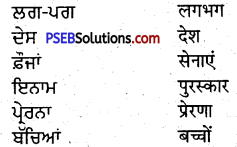
6. ਹੇਠਾਂ ਇੱਕ ਹੀ ਸ਼ਬਦ ਲਈ ਪੰਜਾਬੀ ਅਤੇ ਹਿੰਦੀ ਵਿੱਚ ਭਿੰਨ-ਭਿੰਨ ਸ਼ਬਦ ਹਨ।ਇਹਨਾਂ ਨੂੰ ਧਿਆਨ ਨਾਲ ਪੜ੍ਹੋ ਅਤੇ ਪੰਜਾਬੀ ਦੇ ਸ਼ਬਦਾਂ ਨੂੰ ਲਿਖਣ ਦਾ ਅਭਿਆਸ ਕਰੋ:
ਹੇਠਾਂ ਦਿੱਤੇ ਪੰਜਾਬੀ ਸ਼ਬਦਾਂ ਦੇ ਸਮਾਨ (ਬਰਾਬਰ) ਅਰਥ ਰੱਖਣ ਵਾਲੇ ਹਿੰਦੀ ਦੇ ਸ਼ਬਦ ਲਿਖੋ
ਸਾਡੇ, ਮੀਂਹ, ਹੜ੍ਹ, ਔਖੀ, ਬਾਕੀ, ਨਿੱਕੇ ।
ਉੱਤਰ:


7. ਪੈਰਿਆਂ ਸੰਬੰਧੀ ਪ੍ਰਸ਼ਨ
1. ਹੇਠ ਲਿਖੇ ਪੈਰੇ ਨੂੰ ਪੜ੍ਹੋ ਅਤੇ ਪੁੱਛੇ ਗਏ ਪ੍ਰਸ਼ਨਾਂ ਦੇ ਉੱਤਰ ਦਿਓ- .
ਸਾਡੇ ਦੇਸ਼ ਵਿਚ ਉਸ ਸਮੇਂ ਮੁਗ਼ਲ ਰਾਜ ਕਰਦੇ ਸਨ | ਮੁਗ਼ਲ ਹਾਕਮ ਤਲਵਾਰ ਦੇ ਜ਼ੋਰ ਨਾਲ ਭਾਰਤੀ ਲੋਕਾਂ ਨੂੰ ਮੁਸਲਮਾਨ ਬਣਾਉਣਾ ਚਾਹੁੰਦੇ ਸਨ । ਇਸ ਔਖੀ ਘੜੀ ਵਿਚ ਸ੍ਰੀ ਗੁਰੂ ਗੋਬਿੰਦ ਸਿੰਘ ਜੀ ਮਜ਼ਲੂਮ ਲੋਕਾਂ ਦੀ ਢਾਲ ਬਣੇ । ਮੁਗ਼ਲਾਂ ਨੇ ਅਨੰਦਪੁਰ ਸਹਿਬ ਦੇ ਕਿਲ੍ਹੇ ਨੂੰ ਘੇਰਾ ਪਾ ਲਿਆ | ਕਈ ਦਿਨ ਲੜਾਈ ਚਲਦੀ ਰਹੀ । ਮੁਗ਼ਲ ਫ਼ੌਜਾਂ ਨੇ ਕਸਮਾਂ ਖਾਧੀਆਂ ਕਿ ਜੇ ਗੁਰੂ ਜੀ ਸਿੰਘਾਂ ਸਮੇਤ ਕਿਲ੍ਹਾ ਛੱਡ ਜਾਣ, ਤਾਂ ਅਸੀਂ ਲੜਾਈ ਬੰਦ ਕਰ ਦੇਵਾਂਗੇ। ਉਧਰ ਕਿਲੇ ਵਿਚਲਾ ਰਸਦ-ਪਾਣੀ ਖ਼ਤਮ ਹੋ ਗਿਆ ਸੀ । ਪਹਿਲਾਂ ਤਾਂ ਗੁਰੂ ਜੀ ਕਿਲਾ ਛੱਡਣਾ ਨਾ ਮੰਨੇ ਪਰ ਪੰਜਾਂ ਸਿੰਘਾਂ ਨੇ ਮਿਲ ਕੇ ਗੁਰੂ ਜੀ ਨੂੰ ਬੇਨਤੀ ਕੀਤੀ, ਤਾਂ ਉਨ੍ਹਾਂ ਦੀ ਬੇਨਤੀ ਮੰਨਦੇ ਹੋਏ ਗੁਰੂ ਜੀ ਇਕ ਰਾਤ ਕਿਲ੍ਹਾ ਛੱਡ ਤੁਰੇ । ਉਨ੍ਹਾਂ ਦੇ ਨਾਲ ਖ਼ਾਲਸਾ ਫ਼ੌਜ ਅਤੇ ਪਰਿਵਾਰ ਦੇ ਜੀਅ ਸਨ । ਰਾਤ ਨੂੰ ਮੀਂਹ ਵੀ ਪੈ ਰਿਹਾ ਸੀ । ਮੁਗ਼ਲ ਫ਼ੌਜ ਕਸਮਾਂ ਤੋੜ ਕੇ ਗੁਰੂ ਜੀ ਦਾ ਪਿੱਛਾ ਕਰਨ ਲੱਗੀ ।
ਰਸਤੇ ਵਿਚ ਸਰਸਾ ਨਦੀ ਪੈਂਦੀ ਸੀ, ਜਿਸ ਵਿਚ ਹੜ੍ਹ ਆਇਆ ਹੋਇਆ ਸੀ । ਗੁਰੂ ਜੀ ਵੱਡੇ ਸਾਹਿਬਜ਼ਾਦਿਆਂ ਅਤੇ ਕੁੱਝ ਸਿੰਘਾਂ ਸਮੇਤ ਸਰਸਾ ਨਦੀ ਪਾਰ ਕਰ ਗਏ । ਕੁੱਝ ਪਰਿਵਾਰ ਦਿੱਲੀ ਵਲ ਨਿਕਲ ਗਏ । ਰਾਤ ਦੇ ਹਨੇਰੇ ਵਿਚ ਗੁਰੂ ਜੀ ਦਾ ਪਰਿਵਾਰ ਵਿੱਛੜ ਗਿਆ । ਇਸ ਸਥਾਨ ‘ਤੇ ਅੱਜ-ਕਲ੍ਹ ਗੁਰਦੁਆਰਾ ਪਰਿਵਾਰਵਿਛੋੜਾ ਸੁਸ਼ੋਭਿਤ ਹੈ | ਮਾਤਾ ਗੁਜਰੀ ਜੀ ਅਤੇ ਦੋ ਛੋਟੇ ਸਾਹਿਬਜ਼ਾਦੇ ਗੰਗੂ ਨਾਲ ਉਸ ਦੇ ਪਿੰਡ ਸਹੇੜੀ, ਜ਼ਿਲ੍ਹਾ ਰੂਪਨਗਰ ਆ ਗਏ । ਗੰਗੂ ਗੁਰੂ-ਘਰ ਦਾ ਰਸੋਈਆ ਸੀ । ਮਾਤਾ ਜੀ ਅਤੇ ਬੱਚਿਆਂ ਨੂੰ ਉਸ ਨੇ ਆਪਣੇ ਘਰ ਰੱਖਿਆ । ਗੰਗੂ ਦਾ ਮਨ ਮਾਤਾ ਜੀ ਦੀ ਮੋਹਰਾਂ ਵਾਲੀ ਥੈਲੀ ਵੇਖ ਕੇ ਬੇਈਮਾਨ ਹੋ ਗਿਆ । ਉਸ ਨੇ ਮੋਹਰਾਂ ਵਾਲੀ ਥੈਲੀ ਚੁਰਾ ਲਈ । ਫਿਰ ਇਨਾਮ ਦੇ ਲਾਲਚ ਵੱਸ ਉਸਨੇ ਮਾਤਾ ਜੀ ਅਤੇ ਛੋਟੇ ਸਾਹਿਬਜ਼ਾਦਿਆਂ ਨੂੰ ਮੋਰਿੰਡੇ ਦੇ ਕੋਲ ਫ਼ਿਤਾਰ ਕਰਵਾ ਦਿੱਤਾ ।
ਪ੍ਰਸ਼ਨ 1.
ਮੁਗਲ ਹਾਕਮ ਕਿਸ ਤਰ੍ਹਾਂ ਭਾਰਤੀ ਲੋਕਾਂ ਨੂੰ ਮੁਸਲਮਾਨ ਬਣਾਉਣਾ ਚਾਹੁੰਦੇ ਸਨ ?
ਉੱਤਰ:
ਤਲਵਾਰ ਦੇ ਜ਼ੋਰ ਨਾਲ ।
ਪ੍ਰਸ਼ਨ 2.
ਔਖੀ ਘੜੀ ਵਿਚ ਕੌਣ ਮਜ਼ਲੂਮਾਂ ਦੀ ਢਾਲ ਬਣੇ ?
ਉੱਤਰ:
ਗੁਰੂ ਗੋਬਿੰਦ ਸਿੰਘ ਜੀ ।”
ਪ੍ਰਸ਼ਨ 3.
ਮੁਗ਼ਲ ਫ਼ੌਜਾਂ ਨੇ ਕੀ ਕਸਮਾਂ ਖਾਧੀਆਂ ?
ਉੱਤਰ:
ਕਿ ਜੇਕਰ ਗੁਰੂ ਜੀ ਸਿੰਘਾਂ ਸਮੇਤ ਕਿਲ੍ਹੇ ਨੂੰ ਛੱਡ ਦੇਣ, ਤਾਂ ਉਹ ਲੜਾਈ ਬੰਦ ਕਰ ਦੇਣਗੇ ।
![]()
ਪ੍ਰਸ਼ਨ 4.
ਕਿਲ੍ਹੇ ਵਿਚ ਕੀ ਤੰਗੀ ਆਈ ਸੀ ?
ਉੱਤਰ:
ਰਸਦ-ਪਾਣੀ ਖ਼ਤਮ ਹੋ ਗਿਆ ਸੀ ।
ਪ੍ਰਸ਼ਨ 5.
ਗੁਰੂ ਜੀ ਕਿਲ੍ਹਾ ਛੱਡਣ ਲਈ ਕਿਸ ਤਰ੍ਹਾਂ ਤਿਆਰ ਹੋਏ ?
ਉੱਤਰ:
ਪਹਿਲਾਂ ਤਾਂ ਗੁਰੂ ਜੀ ਕਿਲ੍ਹਾ ਛੱਡਣ ਲਈ ਤਿਆਰ ਨਹੀਂ ਸਨ, ਪਰ ਮਗਰੋਂ ਪੰਜਾਂ ਸਿੰਘਾਂ ਦੁਆਰਾ ਕੀਤੀ ਬੇਨਤੀ ਨੂੰ ਮੰਨ ਕੇ ਉਹ ਕਿਲ੍ਹਾ ਛੱਡਣ ਲਈ ਤਿਆਰ ਹੋ ਗਏ ।
ਪ੍ਰਸ਼ਨ 6.
ਕਿਲ੍ਹਾ ਛੱਡ ਕੇ ਜਾ ਰਹੇ ਗੁਰੂ ਜੀ ਦਾ ਕਿਸ ਨੇ ਪਿੱਛਾ ਕੀਤਾ ?
ਉੱਤਰ:
ਮੁਗ਼ਲ ਫ਼ੌਜਾਂ ਨੇ ਕਸਮਾਂ ਤੋੜ ਕੇ ਗੁਰੂ ਜੀ ਤੇ ਸਿੰਘਾਂ ਦਾ ਪਿੱਛਾ ਕੀਤਾ ।
ਪ੍ਰਸ਼ਨ 7.
ਗੁਰੂ ਨਾਲ ਕਿਸ ਨੇ ਨਦੀ ਪਾਰ ਕੀਤੀ ?
ਉੱਤਰ:
ਵੱਡੇ ਸਾਹਿਬਜ਼ਾਦਿਆਂ ਨੇ ।
ਪ੍ਰਸ਼ਨ 8.
ਜਿੱਥੇ ਗੁਰੂ ਜੀ ਦਾ ਪਰਿਵਾਰ ਵਿਛੜ ਗਿਆ, ਉੱਥੇ ਅੱਜ-ਕਲ੍ਹ ਕਿਹੜਾ ਗੁਰਦੁਆਰਾ ਹੈ ?
ਉੱਤਰ:
ਗੁਰਦੁਆਰਾ ਪਰਿਵਾਰ ਵਿਛੋੜਾ ।
ਪ੍ਰਸ਼ਨ 9.
ਗੰਗੂ ਰਸੋਈਏ ਦੇ ਨਾਲ ਕੌਣ ਸੀ ?
ਉੱਤਰ:
ਮਾਤਾ ਗੁਜਰੀ ਜੀ ਤੇ ਛੋਟੇ ਸਾਹਿਬਜ਼ਾਦੇ ।
ਪ੍ਰਸ਼ਨ 10.
ਗੰਗੂ ਰਸੋਈਏ ਨੇ ਕਿਉਂ ਮਾਤਾ ਜੀ ਤੇ ਛੋਟੇ ਸਾਹਿਬਜ਼ਾਦਿਆਂ ਨੂੰ ਗ੍ਰਿਫ਼ਤਾਰ ਕਰਵਾ ਦਿੱਤਾ ?
ਉੱਤਰ:
ਲਾਲਚ ਵੱਸ ।
2. ਹੇਠ ਲਿਖੇ ਪੈਰੇ ਨੂੰ ਪੜੋ ਅਤੇ ਦਿੱਤੇ ਗਏ ਪ੍ਰਸ਼ਨਾਂ ਦੇ ਉੱਤਰ ਦਿਓ-
ਇਹ ਘਟਨਾ ਸਦੀਆਂ ਬੀਤਣ ਤੇ ਵੀ ਲੋਕਾਂ ਦੇ ਮਨਾਂ ਵਿਚ ਅਜੇ ਤਕ ਵੱਸੀ ਹੋਈ ਸੀ । ਹਰ ਸਾਲ ਦਸੰਬਰ ਦੇ ਪਿਛਲੇ ਹਫਤੇ ਸਾਹਿਬਜ਼ਾਦਿਆਂ ਦੀ ਯਾਦ ਵਿਚ ਸ਼ਹੀਦੀ ਸਥਾਨ ਫਤਿਹਗੜ੍ਹ ਸਾਹਿਬ ਵਿਖੇ ਸ਼ਹੀਦੀ ਜੋੜ ਮੇਲਾ ਲੱਗਦਾ ਹੈ । ਲੱਖਾਂ ਦੀ ਗਿਣਤੀ ਵਿਚ ਲੋਕ ਇਨ੍ਹਾਂ ਮਹਾਨ ਸ਼ਹੀਦਾਂ ਨੂੰ ਆਪਣੀ ਸ਼ਰਧਾ ਦੇ ਫੁੱਲ ਭੇਟ ਕਰਨ ਆਉਂਦੇ ਹਨ । ਤਿੰਨ ਦਿਨ ਦੀਵਾਨ ਸਜੇ ਰਹਿੰਦੇ ਹਨ ਵੱਖ-ਵੱਖ ਬੁਲਾਰਿਆਂ ਵਲੋਂ ਲੋਕਾਂ ਨੂੰ ਜਬਰ ਵਿਰੁੱਧ ਲੜਨ ਲਈ ਪ੍ਰੇਰਿਆ ਜਾਂਦਾ ਹੈ । ਇਨ੍ਹਾਂ ਦੀਵਾਨਾਂ ਵਿਚ ਉੱਚ-ਕੋਟੀ ਦੇ ਰਾਗੀ-ਢਾਡੀ, ਬੀਰ-ਰਸੀ ਵਾਰਾਂ ਤੇ ਕਵਿਤਾਵਾਂ ਸੁਣਾ ਕੇ ਤੇ ਸ਼ਹੀਦੀ ਸਾਕੇ ਨੂੰ ਗਾ ਕੇ ਸੁੱਤੀ ਹੋਈ ਜਨਤਾ ਨੂੰ ਹਲੂਣਦੇ ਹਨ ।ਤਿੰਨ ਦਿਨ ਗੁਰੂ ਕਾ ਲੰਗਰ ਵਰਤਦਾ ਹੈ ਸੜਕਾਂ ਦੇ ਦੋਹਾਂ ਪਾਸਿਆਂ ਤੇ ਪੰਜ-ਛੇ ਕਿਲੋਮੀਟਰ ਤਕ ਬੇਸ਼ੁਮਾਰ ਦੁਕਾਨਾਂ ਲੱਗੀਆਂ ਹੁੰਦੀਆਂ ਹਨ । ਇਹ ਮੇਲਾ ਪਿਛਲੇ ਸਮਿਆਂ ਵਿਚ ਲੋਕ-ਸਭਾ ਦੇ ਤੌਰ ਤੇ ਮਨਾਇਆ ਜਾਂਦਾ ਹੈ । ਪਿੰਡਾਂ ਵਿਚ ਅੱਜ ਵੀ ਇਸ ਮੇਲੇ ਨੂੰ ਸਰਹਿੰਦ ਦੀ ਸਭਾ ਦੇ ਨਾਂ ਨਾਲ ਯਾਦ ਕੀਤਾ ਜਾਂਦਾ ਹੈ ।
ਸ਼ਹੀਦਾਂ ਦੀ ਯਾਦ ਨੂੰ ਤਾਜ਼ਾ ਰੱਖਣ ਲਈ ਹਰ ਸਾਲ ਇਹ ਮੇਲਾ ਮਨਾਇਆ ਜਾਂਦਾ ਹੈ । ਲੋਕ ਮੇਲੇ ਵਿਚ ਜੁੜਦੇ ਹਨ ਤੇ ਜ਼ੁਲਮ-ਜਬਰ ਵਿਰੁੱਧ ਲੜਨ ਦੀ ਪ੍ਰੇਰਨਾ ਲੈ ਕੇ ਮੁੜਦੇ ਹਨ ਸ਼ਹੀਦਾਂ ਦੇ ਨਾਂ ਤੇ ਫਤਿਹਗੜ੍ਹ ਸਾਹਿਬ ਵਿਖੇ ਕਾਲਜ, ਹਸਪਤਾਲ, ਬਿਰਧ-ਆਸ਼ਰਮ ਅਤੇ ਬੱਚਿਆਂ ਲਈ ਸਕੂਲ ਖੋਲ੍ਹੇ ਗਏ ਹਨ ।
ਪ੍ਰਸ਼ਨ 1.
ਸ਼ਹੀਦੀ ਜੋੜ-ਮੇਲਾ ਕਦੋਂ ਅਤੇ ਕਿੱਥੇ ਲਗਦਾ ਹੈ ?
ਉੱਤਰ:
ਸ਼ਹੀਦੀ ਜੋੜ-ਮੇਲਾ ਹਰ ਸਾਲ ਦਸੰਬਰ ਦੇ ਪਿਛਲੇ ਹਫ਼ਤੇ ਸ਼ਹੀਦੀ ਸਥਾਨ ਫਤਿਹਗੜ੍ਹ ਸਾਹਿਬ ਵਿਖੇ ਲਗਦਾ ਹੈ |
ਪ੍ਰਸ਼ਨ 2.
ਸ਼ਹੀਦੀ ਜੋੜ-ਮੇਲੇ ਵਿਚ ਕਿੰਨੇ ਕੁ ਲੋਕ ਹਾਜ਼ਰੀ ਭਰਦੇ ਹਨ ?
ਉੱਤਰ:
ਲੱਖਾਂ ਦੀ ਗਿਣਤੀ ਵਿਚ ।
ਪ੍ਰਸ਼ਨ 3.
ਦੀਵਾਨਾਂ ਵਿਚ ਰਾਗੀ ਤੇ ਢਾਡੀ ਕੀ ਕਰਦੇ ਹਨ ?
ਉੱਤਰ:
ਦੀਵਾਨਾਂ ਵਿਚ ਰਾਗੀ ਤੇ ਢਾਡੀ ਵੀਰਰਸੀ ਵਾਰਾਂ ਤੇ ਕਵਿਤਾਵਾਂ ਸੁਣਾ ਕੇ ਤੇ ਸ਼ਹੀਦੀ ਸਾਕੇ ਨੂੰ ਗਾ ਕੇ ਸੁੱਤੀ ਹੋਈ ਜਨਤਾ ਨੂੰ ਹਲੂਣਦੇ ਹਨ ।
ਪ੍ਰਸ਼ਨ 4.
ਸ਼ਹੀਦੀ ਜੋੜ-ਮੇਲਾ ਕਿੰਨੇ ਦਿਨ ਲਗਦਾ ਹੈ ਤੇ ਕਿੰਨੇ ਦਿਨ ਲੰਗਰ ਵਰਤਦਾ ਹੈ ?
ਉੱਤਰ:
ਸ਼ਹੀਦੀ ਜੋੜ-ਮੇਲਾ ਤਿੰਨ ਦਿਨ ਲਗਦਾ ਹੈ ਤੇ ਤਿੰਨ ਦਿਨ ਹੀ ਲੰਗਰ ਵਰਤਦਾ ਹੈ ।
ਪ੍ਰਸ਼ਨ 5.
ਸ਼ਹੀਦੀ ਜੋੜ-ਮੇਲਾ ਕਿੰਨੇ ਕੁ ਖੇਤਰ ਵਿਚ ਫੈਲਿਆ ਹੁੰਦਾ ਹੈ ?
ਉੱਤਰ:
ਸ਼ਹੀਦੀ ਜੋੜ-ਮੇਲਾ ਪੰਜ-ਛੇ ਕਿਲੋਮੀਟਰ ਖੇਤਰ ਵਿਚ ਫੈਲਿਆ ਹੁੰਦਾ ਹੈ ।
ਪ੍ਰਸ਼ਨ 6.
ਇਸ ਮੇਲੇ ਨੂੰ ਅੱਜ ਵੀ ਕਿਸ ਨਾਂ ਨਾਲ ਯਾਦ ਕੀਤਾ ਜਾਂਦਾ ਹੈ ?
ਉੱਤਰ:
ਸਰਹਿੰਦ ਦੀ ਸਭਾ ।
ਪ੍ਰਸ਼ਨ 7.
ਫ਼ਤਿਹਗੜ੍ਹ ਸਾਹਿਬ ਵਿਚ ਸ਼ਹੀਦਾਂ ਦੀ ਯਾਦ ਵਿਚ ਕੀ ਕੁੱਝ ਖੋਲ੍ਹਿਆ ਗਿਆ ਹੈ ?
ਉੱਤਰ:
ਕਾਲਜ, ਹਸਪਤਾਲ ਤੇ ਬੱਚਿਆਂ ਲਈ ਸਕੂਲ ।
8. ਰਚਨਾਤਮਕ ਕਾਰਜ
ਪ੍ਰਸ਼ਨ 1.
ਆਪਣੇ ਨਜ਼ਦੀਕ ਲੱਗੇ ਕਿਸੇ ਮੇਲੇ ਬਾਰੇ ਪੰਜ ਕੁ ਸਤਰਾਂ ਲਿਖੋ ।
ਉੱਤਰ:
(ਨੋਟ-ਦੇਖੋ ਲੇਖ-ਰਚਨਾ ਵਾਲੇ ਭਾਗ ਵਿਚ “ਅੱਖੀਂ-ਡਿੱਠਾ ਮੇਲਾ’ ।)
9. ਬਹੁਵਿਕਲਪੀ ਪ੍ਰਸ਼ਨ
ਹੇਠ ਦਿੱਤੇ ਪ੍ਰਸ਼ਨਾਂ ਦੇ ਬਹੁਵਿਕਲਪੀ ਉੱਤਰਾਂ ਵਿੱਚੋਂ ਠੀਕ ਉੱਤਰ ਅੱਗੇ ਸਹੀ (✓) ਦਾ ਨਿਸ਼ਾਨ ਲਾਓ
ਪ੍ਰਸ਼ਨ 1.
‘ਸ਼ਹੀਦੀ ਜੋੜ-ਮੇਲਾ ਲੇਖ ਕਿਸ ਦੀ ਰਚਨਾ ਹੈ ?
ਉੱਤਰ:
ਗੁਰਮੀਤ ਸਿੰਘ ਬੈਦਵਾਣ (✓) ।
![]()
ਪ੍ਰਸ਼ਨ 2.
‘ਸ਼ਹੀਦੀ ਜੋੜ-ਮੇਲੇ ਵਿਚ ਕਿੰਨੇ ਸਾਲ ਪੁਰਾਣੀ ਘਟਨਾ ਦਾ ਜ਼ਿਕਰ ਹੈ ?
ਉੱਤਰ:
ਲਗਭਗ ਤਿੰਨ ਸੌ ਸਾਲ (✓) ।
ਪ੍ਰਸ਼ਨ 3.
ਕਿਸ ਗੁਰੂ ਸਾਹਿਬ ਦੇ ਸਾਹਿਬਜ਼ਾਦਿਆਂ ਨੂੰ ਨੀਂਹਾਂ ਵਿਚ ਚਿਣਵਾਇਆ ਗਿਆ ਸੀ ?
ਉੱਤਰ:
ਗੁਰੂ ਗੋਬਿੰਦ ਸਿੰਘ ਜੀ (✓) ।
ਪ੍ਰਸ਼ਨ 4.
ਕਿਸ ਜਗਾ ਗੁਰੂ ਜੀ ਦੇ ਸਾਹਿਬਜ਼ਾਦੇ ਨੀਂਹਾਂ ਵਿਚ ਚਿਣਾਏ ਗਏ ਸਨ ?
ਉੱਤਰ:
ਸਰਹਿੰਦ (✓) ।
ਪ੍ਰਸ਼ਨ 5.
ਮੁਗਲ ਹਾਕਮ ਕਿਸ ਤਰ੍ਹਾਂ ਭਾਰਤੀਆਂ ਨੂੰ ਮੁਸਲਮਾਨ ਬਣਾ ਰਹੇ ਸਨ ?
ਉੱਤਰ:
ਤਲਵਾਰ ਦੇ ਜ਼ੋਰ ਨਾਲੋਂ (✓) ।
ਪ੍ਰਸ਼ਨ 6.
ਗੁਰੂ ਗੋਬਿੰਦ ਸਿੰਘ ਜੀ ਕਿਨ੍ਹਾਂ ਲੋਕਾਂ ਦੀ ਢਾਲ ਬਣੇ ?
ਉੱਤਰ:
ਮਜ਼ਲੂਮ (✓) ।
ਪ੍ਰਸ਼ਨ 7.
ਮੁਗਲਾਂ ਨੇ ਕਿਹੜੇ ਕਿਲ੍ਹੇ ਨੂੰ ਘੇਰਾ ਪਾਇਆ ?
ਉੱਤਰ:
ਸ੍ਰੀ ਅਨੰਦਪੁਰ ਸਾਹਿਬ (✓) ।
ਪ੍ਰਸ਼ਨ 8.
ਗੁਰੂ ਸਾਹਿਬ ਨੇ ਅਨੰਦਪੁਰ ਸਾਹਿਬ ਦਾ ਕਿਲ੍ਹਾ ਛੱਡਣ ਮਗਰੋਂ ਰਸਤੇ ਵਿਚ ਕਿਹੜੀ ਨਦੀ ਪਾਰ ਕੀਤੀ ?
ਉੱਤਰ:
ਸਰਸਾ (✓) ।
ਪ੍ਰਸ਼ਨ 9.
ਸਰਸਾ ਨਦੀ ਪਾਰ ਕਰਨ ਮਗਰੋਂ ਮਾਤਾ ਗੁਜਰੀ ਜੀ ਤੇ ਛੋਟੇ ਸਾਹਿਬਜ਼ਾਦਿਆਂ ਦੇ ਨਾਲ ਕੌਣ ਸੀ ?
ਉੱਤਰ:
ਗੰਗੂ ਰਸੋਈਆ (✓) ।
ਪ੍ਰਸ਼ਨ 10.
ਸਰਸਾ ਨਦੀ ਪਾਰ ਕਰਦਿਆਂ ਗੁਰੂ ਜੀ ਜਿੱਥੇ ਆਪਣੇ ਪਰਿਵਾਰ ਨਾਲੋਂ ਵਿਛੜੇ ਉੱਥੇ ਕਿਹੜਾ ਗੁਰਦੁਆਰਾ ਸੁਸ਼ੋਭਿਤ ਹੈ ?
ਉੱਤਰ:
ਪਰਿਵਾਰ ਵਿਛੋੜਾ ਨੀ (✓) ।
ਪ੍ਰਸ਼ਨ 11.
ਗੁਰੂ ਜੀ ਨਾਲੋਂ ਵਿਛੜ ਕੇ ਮਾਤਾ ਗੁਜਰੀ ਜੀ ਤੇ ਛੋਟੇ ਸਾਹਿਬਜਾਦੇ ਕਿੱਥੇ ਪੁੱਜੇ ?
ਉੱਤਰ:
ਗੰਗੂ ਦੇ ਪਿੰਡ ਸਹੇੜੀ (✓) ।
![]()
ਪ੍ਰਸ਼ਨ 12.
ਗੰਗੂ ਗੁਰੂ-ਘਰ ਵਿਚ ਕੀ ਸੀ ?
ਉੱਤਰ:
ਰਸੋਈਆ (✓) ।
ਪ੍ਰਸ਼ਨ 13.
ਮਾਤਾ ਜੀ ਕੋਲੋਂ ਮੋਹਰਾਂ ਵਾਲੀ ਥੈਲੀ ਕਿਸ ਨੇ ਚੁੱਕ ਲਈ ?
ਉੱਤਰ:
ਗੰਗੂ ਰਸੋਈਏ ਨੇ (✓) ।
ਪ੍ਰਸ਼ਨ 14.
ਮਾਤਾ ਗੁਜਰੀ ਜੀ ਤੇ ਛੋਟੇ ਸਾਹਿਬਜ਼ਾਦਿਆਂ ਨੂੰ ਕਿਸ ਨੇ ਗ੍ਰਿਫ਼ਤਾਰ ਕਰਵਾਇਆ ?
ਉੱਤਰ:
ਗੰਗੂ ਨੇ ।
ਪ੍ਰਸ਼ਨ 15.
ਮਾਤਾ ਗੁਜਰੀ ਜੀ ਤੇ ਛੋਟੇ ਸਾਹਿਬਜ਼ਾਦਿਆਂ ਨੂੰ ਕਿੱਥੇ ਰੱਖਿਆ ਗਿਆ ?
ਉੱਤਰ:
ਠੰਢੇ ਬੁਰਜ ਵਿਚ (✓) ।
ਪ੍ਰਸ਼ਨ 16.
ਸਾਹਿਬਜ਼ਾਦਿਆਂ ਨੂੰ ਕਿਸ ਦੀ ਕਚਹਿਰੀ ਵਿਚ ਪੇਸ਼ ਕੀਤਾ ਗਿਆ ?
ਉੱਤਰ:
ਸਰਹਿੰਦ ਦੇ ਸੂਬੇ ਦੇ ਵਜ਼ੀਰ ਖ਼ਾਨ ਦੀ ਆ ।
ਪ੍ਰਸ਼ਨ 17.
ਵਜ਼ੀਰ ਖਾਂ ਨੇ ਸਾਹਿਬਜ਼ਾਦਿਆਂ ਨੂੰ ‘ਕਿਸ ਗੱਲ ਲਈ ਮਜਬੂਰ ਕੀਤਾ ?
ਉੱਤਰ:
ਮੁਸਲਮਾਨ ਬਣਨ ਲਈ (✓) ।
ਪ੍ਰਸ਼ਨ 18.
ਸਾਹਿਬਜ਼ਾਦਿਆਂ ਨੇ ਜ਼ੁਲਮ ਅੱਗੇ ਝੁਕਣ ਦੀ ਥਾਂ ਕੀ ਮਨਜ਼ੂਰ ਕੀਤਾ ?
ਉੱਤਰ:
ਸ਼ਹੀਦੀ ਦੇਣੀ (✓) ।
ਪ੍ਰਸ਼ਨ 19.
ਸ਼ਹੀਦੀ ਜੋੜ-ਮੇਲਾ ਹਰ ਸਾਲ ਕਦੋਂ ਲਗਦਾ ਹੈ ?
ਉੱਤਰ:
ਦਸੰਬਰ ਦੇ ਪਿਛਲੇ ਹਫ਼ਤੇ (✓) ।
ਪ੍ਰਸ਼ਨ 20.
ਸ਼ਹੀਦੀ ਜੋੜ-ਮੇਲਾ ਹਰ ਸਾਲ ਕਿੱਥੇ ਲਗਦਾ ਹੈ ?
ਉੱਤਰ:
ਸ਼ਹੀਦੀ ਸਥਾਨ ਫ਼ਤਿਹਗੜ੍ਹ ਸਾਹਿਬ ।
ਪ੍ਰਸ਼ਨ 21.
ਸ਼ਹੀਦੀ ਜੋੜ-ਮੇਲਾ ਕਿੰਨੇ ਦਿਨ ਲਗਦਾ ਹੈ ?
ਉੱਤਰ:
ਤਿੰਨ ਦਿਨ ਐ (✓) ।
ਪ੍ਰਸ਼ਨ 22.
‘ਮੁਗ਼ਲ ਫ਼ੌਜ ….. ਤੋੜ ਕੇ ਗੁਰੂ ਜੀ ਦਾ ਪਿੱਛਾ ਕਰਨ ਲੱਗੀ । ਇਸ ਵਾਕ ਵਿਚਲੀ ਖ਼ਾਲੀ ਥਾਂ ਵਿਚ ਭਰਨ ਲਈ ਕਿਹੜਾ ਸ਼ਬਦ ਢੁੱਕਵਾਂ ਹੈ ?
ਉੱਤਰ:
ਘੇਰਾ (✓) ।
